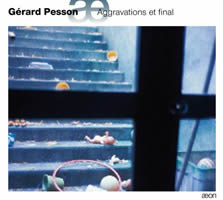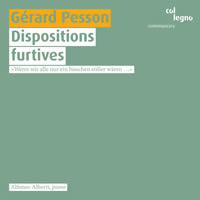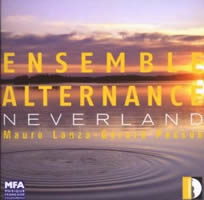Graceful Illusionist: Gérard Pesson
|
Grant Chu Covell [October 2012.]
“Dispositions furtives.” Gérard PESSON: La lumière n’a pas de bras pour nous porter (1994); Vexierbilder II (2003); Vexierbilder, Rom (1994-95); Butterfly’s Note-Book (1995-1998); Trois Pièces pour piano (2008); Trois Petites Études mélancoliques (1991); Dispositions furtives (en album) (1983); Folies d’Espagne (1997); selections from Musica Ficta (1999-2008). Alfonso Alberti (pno). col legno WWE 1CD 20285 (1 CD) (http://www.col-legno.de/). “Aggravations et final.” Gérard PESSON: Rescousse (marginalia) (2004-5); Vexierbilder II (2003); Aggravations et final (2002); Cassation (2003); Wunderblock (Nebenstück II) (2005). Hermann Kretschmar (pno), Teodoro Anzellotti (accordion), WDR Sinfonie Orchester Köln, Lucas Vis, Johannes Kalitzke (conds.), Ensemble Modern, Brad Lubman (cond.). Aeon AECD 0876 (1 CD) (https://outhere-music.com/aeon). Gérard PESSON: La vita è come l’albero di Natale (1992); Non sapremo mai di questo mi (1991); Mes béatitudes (1994-95). Mauro LANZA: Barocco (1998-2003); The skin of the onion (2002); La coquille de l’escargot (1996). Ensemble Alternance, Robert H.P. Platz (cond.). Stradivarius STR 33755 (1 CD) (http://www.stradivarius.it/). It would be cruel to call Gérard Pesson the Französisch Lachenmann (or the francese Sciarrino). It’d be better for us to think of Pesson as a graceful illusionist. Indeed Lachenmann has accused him of “magic by the void,” whatever that means. Words fail when describing Pesson’s universe. He is a poet who unites Beethoven’s rhythmic snap with a caustic vocabulary including non-standard noises. Pesson achieves fragile magic through hinting and erasing. (The 2000 opera Forever Valley was covered here.) Music often defies words, so let’s get to specifics. Pesson enjoys puzzles, specifically musical representations of visual illusions, like that goblet which may actually be two faces in profile. Musical puzzles resist explication: How can one phrase suggest something else? How does one structure hint at its opposite? Consider the three pieces in Pesson’s Vexierbilder II (“Illusions”) which mandate the virtuosity required for Ligeti’s Études, although calisthenics are downplayed when pieces pass quickly and camp in narrow registers. Speech of Clouds begins with rapid figurations in close position. Later some pitches will be omitted at the pianist’s discretion. Negation frames music with silence, or maybe it is the other way around. In Rondo the theme dissipates after each repeat. Vexierbilder II’s last piece plays with memory by reusing material from Speech of Clouds (which in turn suggests a phrase from Boulez or Stockhausen). Harmony and development don’t apply here; there is no forward motion, only effacement. Two different recordings of Vexierbilder II have popped out of the woodwork. I’d expect to find col legno’s Alberti hiding in a lamppost’s shadow whereas Aeon’s Kretschmar stands tall in a field. Col legno prefers a softened acoustic; Aeon opts for directness. Of course Alberti’s disc-length program required more contouring and greater reserves. Traditional gestures (repeated notes, reminiscences of other genres) and extended techniques (pedal noises, fingernails scraping, piano action sounds) are more striking in Alberti’s rendition. Satie makes a plausible ancestor, although Pesson prefers the gallows. Draped across light scaffolding, Pesson’s pithy gestures and precise ornamentation efficiently insinuate his ideas. A spotlight may shine briefly upon a four-note turn, a momentary emphasis meant to trigger similar moments in other music. Some passages suggest notes not played: Folies d’Espagne’s clichés are immediate, however, we hear the tails of phrases. It’d be possible to hear the work but not be in on the joke. Pesson seamlessly incorporates extended technique such as running fingernails against the keys (La lumière n’a pas de bras pour nous porter), mechanical noises (Butterfly’s Note-Book: Vicissitudes du Père), and interior/prepared sounds (Three Pieces: No. 3). Continuously repeating notes (Lux retraité tierce) recall Ravel’s Le Gibet. Alberti’s concluding Excuse my dust from the aptly named collection, Musica Ficta, is a mere eleven-second salute, not unlike what might be heard accidentally if dusting a piano. Beyond Vexierbilder II, Aeon offers surfaces suggesting Lachenmann’s and Sciarrino’s unvarnished textures, except the rubbings and scrapings reveal others’ works underneath. The perfectly named Wunderblock offers an easy entry point. Freud compared human memory to the child’s plaything known as a Magic Slate or Wunderblock where a drawing can be made on plastic covering a wax board. Lift the plastic and the image vanishes, but traces remain upon the wax. In Pesson’s Wunderblock an accordion wanders through orchestral remains. We hear familiar fragments and the effect is like trying to make sense of a peeling billboard. In truth, the few notes that are actually there are taken directly from the Allegro of Bruckner’s Sixth. Imagine the symphony washed away, or as Pesson suggests, envisage “…an object that had fallen into the sea and which, oxidized and covered with coral, is both emphasized by the additive wear and concealed from one’s gaze.” (Wunderblock’s subtitle is Nebenstücke II. For the first Nebenstücke a clarinet quintet erases Brahms’ Fourth Ballade, Op. 10.) As a Bruckner fan, it excites to hear the familiar nip at our heels. However the actual original is so scant that it’s easy to imagine stumbling across the piece and not recognizing the pentimento. Quite likely my memory tricks me into hearing more Bruckner than is there. I appreciate the symphony more without actually hearing all of it. The wheezing accordion suggests Bruckner at the organ improvising for a circus. Indeed Pesson’s distortion emphasizes the original’s textual and motivic variety. Aeon’s title work, Aggravations et final suggests tape manipulation. How else to describe the sudden jumps and the way a familiar phrase will skitter across (Bruckner again) only to be repetitively trimmed to one chord and then be left to gasp for breath. Bearing in mind my fondness for Andriessen, Romitelli and Lang’s similar techniques, I note that Pesson’s utilizes more classic ingredients. The disc’s opening Rescousse hides Flamenco, more Bruckner, a page of Lachenmann, and more. Here is where Pesson shows muscle with complex, rapid filigree. Quick sidebar: Let’s talk about the “other Pesson.” Top search hits connect Pesson with Laurence Equilbey’s Accentus choral ensemble. There is a strong tradition of fitting words to existing instrumental compositions, e.g., “This is the symphony that Schubert never finished,” and “Answer the telephone.” Naïve’s “Transcriptions” (Naïve V 4947) includes a cappella choral works derived from Chopin, Debussy and Vivaldi. Pesson applied several August von Platen texts to the Adagietto of Mahler’s Fifth without besmirching the original. The choral transcription, Kein deutscher Himmel (1996-97), maintains Mahler’s loveliness. There is also a transcription of the sixth movement of Mahler’s Third applying words by Martin Kaltenecker, Von der Liebe. Pesson’s chamber works can be astonishingly short. A Stradivarius release offers the miniatures La vita è come l’albero di Natale and Non sapremo mai di questo mi, less than two minutes each. Franck’s Violin Sonata surfaces in the violin-piano duo La vita, and Mozart hides in the trio Non sapremo for flute, violin and piano. On the same disc Mes béatitudes looks like a piano quartet, with ingenious sounds creating a cosmos. We hear the composer’s pencil scratching at paper rather than the configuration popularized by Brahms, et al. Of course Bruckner lurks too: Bits from the Seventh’s Adagio lunge like horror-movie zombies. (Pesson shares the program with Lanza, hardly a slouch: Barocco blends a soprano with an ensemble of toys.) Aeon includes Cassation for clarinet, string trio and piano, mysterious company for the strings’ pluck and strum to simulate broken guitars. The clarinet wanders as if to survey the wreckage. Pesson’s program notes are absurdly obtuse. Best to ignore them and fall through the floor unassisted.
[More Grant Chu Covell]
[Previous Article:
Glidin' 'n' Slidin']
[Next Article:
Feldman's Crippled Symmetry]
|


